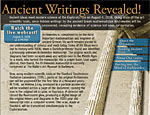Tina Rosenberg in the New York Times Magazine:
Mothers with H.I.V., the
virus that causes AIDS, pass it along to their newborns at birth 25 to 30 percent of the time, and in poor countries, some half a million babies a year are born with H.I.V. But the rate of transmission can be cut to 14 percent with a simple and cheap program: H.I.V.-positive mothers take a single pill of an antiretroviral called nevirapine when they begin labor, and their newborns are given nevirapine drops. At the Alexandra Health Center and University Clinic in
South Africa, pregnant women can get nevirapine free. The antenatal clinic is a complex of low brick buildings on a pretty hospital campus in the middle of the township of Alexandra, a bleak neighborhood on the outskirts of Johannesburg. The clinic has a doctor only on Thursdays, but an advanced midwife and two nurses attend a crowd of patients every day. I had been in South Africa for four days when I visited the clinic, and I had already seen the stigma that AIDS still carries in the country — those dozens of funerals every Saturday in the townships? Oh, say family members, it was asthma, or tuberculosis, or “a long illness.” I thought I understood how powerful denial could be. But I was unprepared for what Pauline Molotsi, a registered nurse at the clinic, told me. About twice a week, a woman who has tested H.I.V.-positive begins labor at the clinic but refuses to take the nevirapine that might save her baby’s life. “She says, ‘Oh, no, I’m not positive,”’ Molotsi told me.
More here.



















